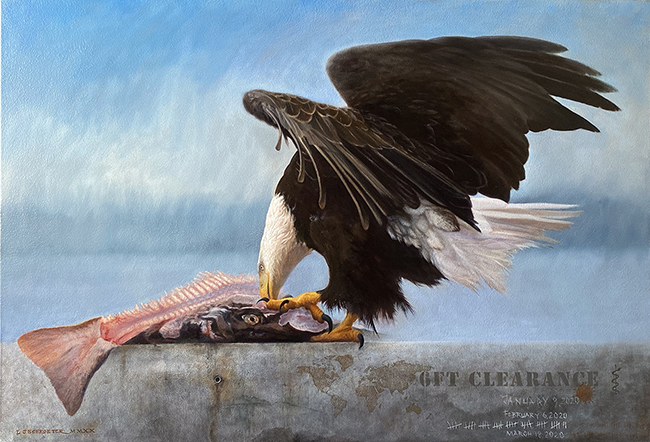Linda J Schroeter, an Australian artist, weaves narratives through her canvases. Each stroke, each layer of paint tells a story – a story deeply rooted in the artist’s experiences, observations, and a profound connection with nature. Linda’s work, characterized by allegory and symbolism reminiscent of the Dutch masters, transcends mere visuals; it beckons viewers into a reflective dialogue on the human impact on nature.

Linda’s artistic journey is a dance of ideas and inspiration. She reveals, “Each painting starts with an idea sparked by something I’ve found or purchased, or it can be a story that either refers to a personal event or has a significant narrative or theme element.” This intentional connection to personal experiences infuses her work with authenticity and invites viewers to explore the layers of meaning embedded within.
The Dutch masters, known for their allegorical and symbolic works, serve as a wellspring of inspiration for Linda. Her dedication to traditional painting techniques, manipulating light through paint layers, and pushing the boundaries of form and elements reflects a commitment to craftsmanship. The result is a collection of paintings that exude a profound sense of three-dimensional space, drawing the observer into a world where every detail matters.
One of Linda’s notable works, titled “A Tail of Two Fish,” unveiled in 2020, is a testament to her ability to capture the essence of life’s perpetual cycle. Measuring 24″ x 35″ and crafted with oil on linen, this painting becomes a poignant commentary on the delicate balance of nature. In the midst of the 2020 pandemic lockdown, Linda brings forth a dance of survival between a symbolic eagle and its sustenance. The composition serves as a mirror to the struggles of life, urging viewers to reflect on the intricate web of existence.
Linda elaborates on the piece, stating, “A Tail of Two Fish embodies the raw essence of life’s perpetual cycle invoking reflection on nature’s delicate balance. This painting’s intention is to awaken a reflective dialogue on humans’ impact and cumulative destruction of nature.” The choice of the word “dialogue” is deliberate – Linda’s art is not a monologue; it’s an invitation for viewers to engage in a conversation with the canvas, with nature, and with themselves.
Linda’s work doesn’t seek embellishments; instead, it relies on the power of metaphor and imagery to communicate. The deliberate use of traditional techniques enhances the impact, creating paintings that are not only visually striking but also intellectually stimulating. Linda’s intent is clear – to connect emotionally and intellectually with the viewer through the language of art, fostering a deeper understanding of our relationship with nature.
As we explore Linda J Schroeter’s body of work, we find a recurring theme – a call to awareness. Her paintings serve as mirrors reflecting the consequences of human actions on the environment. In a world where nature often bears the brunt of progress, Linda’s art becomes a silent protest, urging us to reconsider our impact and tread lightly on the delicate balance of the natural world.
In conclusion, Linda J Schroeter’s art is a profound testament to the power of visual storytelling. Through allegory, symbolism, and traditional techniques, she crafts a narrative that transcends time and space, beckoning viewers to join in a reflective dialogue. In a society often overwhelmed by the cacophony of modern life, Linda’s works serves as a gentle reminder to pause, reflect, and appreciate the intricate dance of life captured on her canvases.

